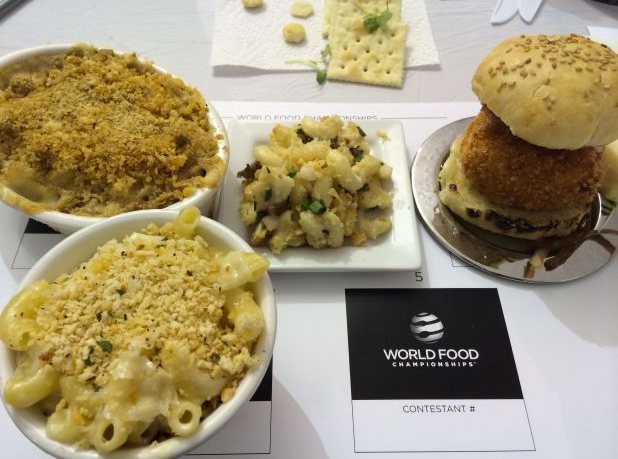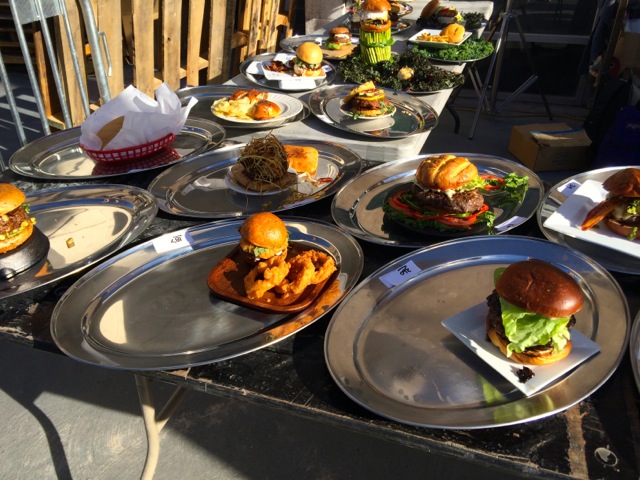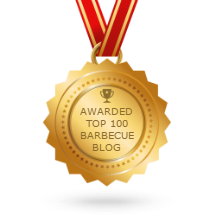Judging at the World Food Championships 2013
Back and rested from the World Food Championships in Las Vegas, Nevada, November 7 – 10, 2013. I was fortunate enough to be a judge at two events: Recipes and Hamburgers. Over 1000 people applied and a select few where chosen for the opportunity to be one of 350 food judges required for this event. I would be at a complete loss to define the requirements of being a food judge at this event as there were some people that I met that had no previous experience at all, yet some were clearly professional Chefs. Mixed amongst the group were lawyers, journalist, food bloggers, Home cooks, lobbyist (yep) and many more backgrounds were in attendance. I only had time to meet a few during the judging of events, but what an experience!
We started out with a Judges meeting that reviewed the expectations of being a judge with the importance of discretion and not fraternizing with the contestants, good points to everyone there as some where clearly contestants as well. We had previously received a judges packet that contained all of the important info we needed to judge this event so they didn't review to much but gave us a review of the EAT™ judging method:
EAT™ Method
The EAT™ Method is the World Food Championships own proprietary scoring system and methodology that allows any WFC categories to be judged on the same criteria in a consistent manner.
Judges will score each offering in each of three categories, on a scale of 1(inedible) to 10 (perfect). If an entry is not submitted on time, a 1 shall be given in each of the three categories.
Appearance – When judging for the World Food Championships a judge should assess the product on how it appears. A judge may take plating and garnish into consideration, but must score the completed food product as the majority of the cumulative decision. As an example, judges may deliberate on questions like: does this product look like it should? What was the cook attempting to accomplish with appearance? Is the product aesthetically pleasing? Based on sight alone, does this entry make me want to eat it?
Taste – When scoring taste, judges may deliberate on questions like: does this product taste like it should? What was the cook attempting to accomplish? Were they successful? Was it flavorful?
Execution – Appearance is assessed through the eyes. Taste is assessed through the mouth. Execution covers all other components. Mostly a judge should ask themselves: What was the cook attempting to accomplish? Were they successful? Does the entry adequately represent the category turn-in specifications? Execution should cover, but not be exclusive to, components like creativity, aroma, fundamental cooking, temperature, difficulty and category accuracy.
As a judge you were scheduled to judge one of several events: BBQ, Chili, Bacon, Sandwich, Dessert , Recipe (Pasta) or Hamburgers. Every Judge received a swag bag of goodies which included a couple of cook books and smaller nic-nacs of stuff. Then they cut us loose until or scheduled time.
What does judging look like? Well, it is a bunch of people sitting at a table trying not to eat everything placed in front of them and making decisions on whether or not the sample placed in front of them rate a 1 or a 10, or something in between.
But there are guidelines:
Judging Guidelines
Competitors at the World Food Championships will invest considerable amounts of money, time and energy to compete in the Ultimate Food Fight. We ask that all judges consider the effort put forth by the competitors, and the privilege of being selected to judge and take their crucial role in determining the outcome of this event very seriously.
1) Judges are required to be prompt and attend all Judges Meetings and Competition Judging that are required per your commitment.
2) Judges may not fraternize with teams on turn-in day until conclusion of judging.
3) Only Judges, Contest Reps and necessary support staff are allowed in judging area during the judging process. No other activities are permitted in the judging area, during judging process.4) Judges are asked to remain silent during the judging period when samples are being distributed and while scores are being assessed by judges. Between turn-ins and after judging, judges are allowed to converse.
5) Judges are asked to remain impartial and evaluate each entry on their own merits. Judges, during the opening rounds, should not attempt to communicate with other judges, verbally or non-verbally, in an attempt to sway the opinion of another judge.6) Competition administrators and table captains will be present to assist with any questions a judge may have about the competition/judging.
7) Judges are asked to dress conservatively and appropriately. WFC will provide T-shirts for all judges. T shirts will be distributed at the All Judges meeting as well as on-site previous to the judging period.8) All food for judging is to remain in the judging area, WFC staff will dispose of any excess food.
For the most part these are strictly adhered to.
Once we are called to order, the food starts arriving on trays delivered by our table captain. The table captain can only tell us the number of the tray and we write this down on our samples sheet and judging form. The tray is then presented to the judges for “Appearance” and there is usually one “Appearance sample” and several judges samples on the tray as well or just judges samples (there were five judges at each table) for us to look at. There is no touching, asking questions or even what the recipe ingredients are to guide us in making our evaluation. Judging for “Appearance” is every bit as difficult as “Tasting” or “Execution” as it is a visual review only.
Appearance/Presentation:
Once the competitors have turned in their cooked product the tray will be renumbered by a WFC official. The tray will be presented to the judges for appearance judging. A table captain will show the tray to the table and slowly rotate so all judges at the table have adequately viewed the offering. Judges will note the tray number on both their scorecard and the placemat. Judges will then reach for, and take, a sample portion of the food entry.
Once we have scored for “Appearance” we then place our sample on the sample placemat and wait for the next sample tray to be presented (though there are 5 places on the sample placemat we were only judging 4 samples). We then go through the process again until all trays have been presented.
Now we get to taste the food!
Sampling:
Once each of the entries has been presented and scored on Appearance, Judges can begin sampling. Judges may sample all of the competition offerings at once before beginning to score, or as a process along the way.
Taste – When scoring taste, judges may deliberate on questions like: does this product taste like it should? What was the cook attempting to accomplish? Were they successful? Was it flavorful?
Note: We were not allow to “deliberate” during this process and perhaps I read the above wrong? Deliberate with myself? I guess in Las Vegas that would be acceptable…
Tasting competition food is tough, we have to judge each one on its own merits and not compare them with each other, easier said than done. Between each sample we are allowed to cleanse our palette with water and crackers to remove any linger taste that might affect our scoring of the next sample. It is my advice, if you ever get a chance to judge, that you only take enough bites to make a decision about the food. Ignore the temptation to finish the sample as this can heavily alter your taste sensations before moving on to the next sample, besides the fact that you could be consuming as much as 2 pounds of food by the time you are done!
“Execution” is to be scored at the same time as “Taste”.
Execution
Appearance is assessed through the eyes. Taste is assessed through the mouth. Execution covers all other components. Mostly a judge should ask themselves: What was the cook attempting to accomplish? Were they successful? Does the entry adequately represent the category turn-in specifications? Execution should cover, but not be exclusive to, components like creativity, aroma, fundamental cooking, temperature, difficulty and category accuracy.
Never once did I see anyone sample with their noses, aroma is critical in my opinion and your should be using all of your senses to judge. Take garlic as an example – it's aroma when raw is bitter and pungent, cooked it is sweet and aromatic, but if for some reason part of the dish is prepared on the cutting board that the garlic was chopped on, those bitter and pungent odors could transfer to the completed dish affecting the overall result.
The scoring system was a 1 through 10 rating
During WFC Judging each criteria will be judged on a scale of 1 (inedible) to 10 (perfect).
We are leaning towards perfect (10) for an event like this, this would seem to be the expectation the judges delivered. Though I wasn't able to discuss scores during the judging process, we could discuss our scores after everyone turned the score cards in. There were no 4, 5 or 6's in our group, which leads me to believe that everyone scored higher than need be with little room for “perfect” with 7, 8, and 9's being the norm. Flawed? Perhaps, as I would like to see the baseline start at 5 and the truly exceptional dishes scale up from there. A small rant on my part…
So we sample, taste, poke, taste, and evaluate the dishes presented by the teams that worked their tails to the bone to get here and compete in cooking stations far different than what they practiced on and equipment that they never have used before. Stuffed and rsolute in our decisions, we turn our cards in for the tally.
The volume of food presented during this event was staggering and the photo above is half of what would be turned in for this particular category (Hamburgers).
I judged 2 categories on my judging day, Recipes (Pasta & Mac and Cheese) and Hamburgers (Hamburgers & Patty Melts). Each category had 2 turn ins, their main dish as in the case of Hamburgers would be a Hamburger and then a “Structured” dish that was a “Patty Melt”, o I had a total of 16 sample to judge by the time I was done, whew!
The judging experience at the World Food Championships was priceless and I am looking forward to doing it again next year. With judging at the International Dutch oven Championships and the World Food Championships under my belt I can now look forward to fulfilling my Masters card for the KCBS BBQ competitions (only 40 of those to do) next year. 2014 should be a great year!
There are no judging classes to learn how to do this except for the KCBS certificate and I throw out that the WFC should consider doing something like this for future events.
See ya on the food judging circuit!




